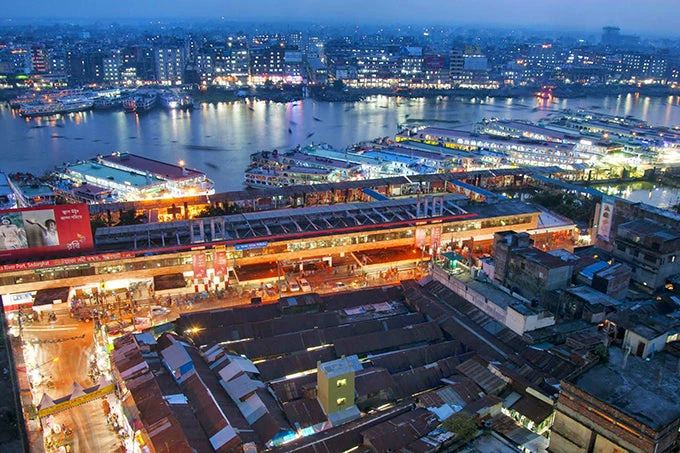
If, like me, you’re a firm believer in New Year’s resolutions, early January ushers in the prospect of renewed energy and exciting opportunities. And as tradition has it, it’s also a time to enter the prediction game.
Sadly, when it comes to the global economy, this year’s outlook is taking a somber turn.
In the aptly titled Darkening Skies, the World Bank’s new edition of its twice-a-year Global Economic Prospects report shows that risks are looming large on the economic horizon.
To sum up: In emerging market and developing economies, the lingering effects of recent financial market stress on several large economies, a further deceleration in commodity exporters are likely to stall growth at a weaker-than-expected 4.2 percent this year.
On a positive note, South Asia is set to remain relatively insulated from some of these rising global uncertainties and will retain its top spot as the world’s fastest-growing region.
Bucking the global decelerating trend, growth in South Asia is expected to accelerate to 7.1 percent in 2019 from 6.9 percent in the year just ended, bolstered in part by stronger investments and robust consumption.
Among the region’s largest economies, India is forecast to grow at 7.5 percent in fiscal year 2019-20 while Bangladesh is expected to moderate to 7 percent in fiscal year 2018-19. Sri Lanka is seen speeding up slightly to 4 percent in 2019.
Notably, and despite increasing conflicts and growing fragility, Afghanistan is expected to increase its growth to 2.7 percent rate this year.
In this otherwise positive outlook, Pakistan’s growth is projected to slow to 3.7 percent in fiscal year 2018-19 as the country is tightening its financial conditions to help counter rising inflation and external vulnerabilities.
However, activity is projected to rebound and average 4.6 percent over the medium term.

And to reach that goal, the region is committed to getting its business environment in better shape to create more and better jobs for its people.
That was one of the main takeaways from the latest Doing Business 2019, which shows how South Asia has made further gains to improve the ease of doing business and carried out a total of 19 business reforms in the past year--the second highest number ever.
Specifically, and in a first for South Asia, two of the region’s economies, India and Afghanistan, earned coveted spots as global top improvers.
This strong reform agenda reflects a political commitment across the region to lift barriers affecting businesses, especially local small and medium-sized enterprises, and unleash innovation and technological progress that drive growth.
However, several risks may hamper South Asia’s growth momentum.
First, South Asian economies have among the highest levels of public debt in the world. These fiscal burdens could store up trouble for the future and make the region more vulnerable to a faster-than-expected tightening of global financial conditions.
Further to that, tax revenue is consistently low across most South Asian countries and at rates below that of other developing countries with a similar income per capita.
To be true, some countries have expanded their tax bases and curbed tax exemptions and fraud, but their revenue remains lower than government expenditures, creating large fiscal deficits that need to be financed through public borrowing.
But beyond its persistent budget deficits and high levels of debt, South Asia faces an even more pressing challenge to sustain its growth progress—namely, the region is not investing enough in the health, skills, and education of its people.
Investing in people early, and often, can lay a strong foundation for the growth and competitiveness of nations.
That is, chiefly, the upshot of the Human Capital Project, a global effort led by the World Bank to accelerate investments in people for greater equity and economic growth.
And in that regard, South Asia – home to 33 percent of the world’s poor – needs to do a much better job.
The Bank’s Human Capital Index which ranks 157 economies on indicators like child mortality, health, and education shows that children born in South Asia still have ways to go to achieve their full potential--especially in Afghanistan (#133), Bangladesh (#106), India (#115), Nepal (#102), and Pakistan (#134).
On the bright side, Sri Lanka is ahead of other South Asian countries and ranks at #74—higher than could be expected for its income level
Stunting in South Asia remains the highest in the world, with 36 percent of children stunted or of low height for their age.
Across the region, almost 13 million children of primary age are still out of school, and even when kids go to school the quality of learning falls behind – for example, many students are not able to read grade-relevant text in their own language.
With technology changing the very nature of work, investing in human capital has never been more critical.
And while progress in building human capital is hard to achieve, South Asia has proven it can pursue challenging reforms to grow its economies, invest in health and education, and spread prosperity more widely.
In that journey, we’re dedicated to continuing our work with governments in the region to secure a brighter future for their people.


Join the Conversation